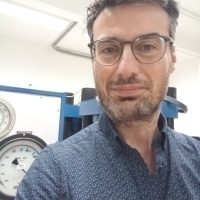
Portrait of Fabrice Gaillard
July 29th, 2022
Presentation
Fabrice Gaillard, Researcher at ISTO (Magma team leader)
Field of research or activity
I work on magmatism. I am interested in the long-term consequences of magmatism on a variety of processes on Earth and elsewhere in other planetary systems. Volcanism is an immediate manifestation of magmatism, and I am interested in its role in the composition and evolution of planetary atmospheres and surfaces. The nitrogen in our atmosphere is certainly of magmatic origin, and volcanoes also contribute to the emission of carbon dioxide and sulfur dioxide, but the evolution of this volcanic degassing over time remains enigmatic. Finally, most of the magmas do not erupt and remain trapped in depth by unknown mechanisms, so that eruption is an exception to magmatism. These deep magmas have an impact on the chemical, mechanical and thermal properties of the earth’s crust. I am working on methods to detect these deep magmas and define their physical state. Are they pockets filled with liquid or are they portions of the earth’s crust impregnated with tiny amounts of liquid? Finally, these deep magmas are at the origin of the formation of many mineral resources necessary to our societies. How does this deep distillation work? How are metals such as copper, gold, rare earths, or lithium concentrated by magmatism to constitute mining deposits?
How do you do it?
Simulation by experiment and by calculation is at the heart of my scientific approach. Magmatic processes operate hidden in depth and are often affected by thousands or even millions of years of life of a magmatic system. Conducting laboratory experiments by reconstructing the temperature and pressure conditions of the Earth’s interior is an approach that allows us to recreate the conditions of magmatism, identify important parameters, decipher mechanisms, and determine laws. The strength of experimentation lies in the simplification of magmatic processes by imposing simplified chemical systems, unique pressure and temperature conditions. Numerical simulation is the natural complement and extension of the experimental approach since it allows the simulation of empirical laws in the diversity and complexity of magmatic conditions.
In the laboratory, we develop state-of-the-art technologies to reproduce the conditions of magmatism. We use presses and autoclaves allowing to reach extreme conditions of pressure (200 to 40000 times the atmospheric pressure) and very high temperatures (>1200°C).
For what purpose?
To understand how nitrogen left the Earth to enter the atmosphere requires travelling in time, in the history of our planet; to understand where, and of what, magmatic reservoirs are made requires travelling in the interior of the Earth; to understand how lithium, a rare chemical element, can be concentrated in certain magmas up to contents of several percent requires travelling in time and in the interior of the Earth. There are real methodological challenges to solve these impossible journeys, but there is a real need for answers on the role of magmatism on the habitability of a planet, on the risk associated with eruptions and non-eruptions, and on the critical issue of mineral resources for our societies. Geology is at the heart of our societal questions about the origins and resources of our world.


